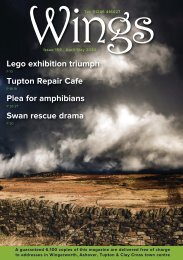Twist Issue 161 May 2024
You also want an ePaper? Increase the reach of your titles
YUMPU automatically turns print PDFs into web optimized ePapers that Google loves.
Tw st<br />
Moon<br />
craters<br />
identified<br />
I<br />
40<br />
‘VE picked out four different craters for us to track down,<br />
one in each of the four quadrants, and with the best<br />
viewing dates for them scattered throughout the month.<br />
All are visible with the naked eye, but anyone with binoculars or<br />
any size of telescope will be well set to spot even more detail.<br />
Our Lunar month for ‘<strong>May</strong>’ actually starts with the new moon on<br />
<strong>May</strong> 8th this year, and will continue right through to June 5th. Each<br />
quarter of a Lunar month takes approximately one week.<br />
The new Lunar month begins with the New Moon, when it is<br />
completely dark and obscured. Within the first couple of days, the<br />
bright crescent sliver will appear to the right in a 'reverse-C shape'.<br />
We'll introduce a term here called the 'Lunar Terminator',<br />
which is the technical name for the dividing line<br />
between day and night on the moon's surface. All<br />
objects orbiting a sun will have their own<br />
terminator - the Terrestrial (Earth's)<br />
Terminator passes over us every single<br />
dawn and dusk.<br />
After around one week, the Moon will<br />
be at First Quarter, with the Terminator<br />
exactly bisecting the disc, the left half in<br />
darkness and the right side well-lit.<br />
Second quarter will see the Moon<br />
become full, and the terminator<br />
disappear entirely off the left side of the<br />
disc. A new terminator will begin to<br />
cross, again from right-to-left. Third<br />
Quarter will see the terminator again<br />
exactly bisecting the face, but this time with<br />
the left half well-let, and the right side in<br />
darkness.<br />
The final days of the lunar month, in very-early<br />
June, will see a 'correct-C shape' crescent on the lefthand<br />
side, shrinking until it disappears for the next New<br />
Moon.<br />
It may be tempting to try and spot our lunar features<br />
during the Full Moon, and it's true that this is when the Moon is often<br />
brightest. However it's not necessarily the best option for two<br />
reasons. Firstly, the Full Moon can be so bright compared to the<br />
night, that it can saturate our night vision, ruining our ability to spot<br />
fine detail. Secondly, when the Moon is full, the angle of the sunlight<br />
illuminating the face is very direct, which tends to remove any<br />
shadows cast by the lunar geography, and remove a lot of contrast<br />
that would help us pick out the features, making everything blend<br />
into everything else.<br />
Instead, we'll come back to our terminator line. The best time for<br />
spotting detail in a lunar feature is the few days while it is only-just<br />
on the light-side of the terminator. Sometimes this will be a few days<br />
before the terminator crosses a feature, while in the other half of the<br />
D<br />
C<br />
A: Langrenus; B: Plato;<br />
C: Tycho; D: Grimaldi<br />
This month,<br />
Chesterfield<br />
astronomer Phil<br />
Unsworth takes <strong>Twist</strong><br />
readers crater<br />
spotting on the Moon<br />
Picture:<br />
Claire Davison<br />
lunar month, it will be the few days after the terminator has already<br />
passed. Best dates for spotting our four craters are listed at the end.<br />
We'll start with Langrenus Crater in the East, a light-coloured crater<br />
right on the Eastern edge of one of the darker 'Maria' (Seas).<br />
Langrenus is approximately round, but due to our viewpoint of it on<br />
the extreme Eastern edge, it will appear as an elongated oval. The<br />
darker Maria are actually lowlands that long ago filled with flowing<br />
lava. The lava cooled to form basalt plains. This basaltic lava is ironrich<br />
in comparison to the highlands, with the iron giving the resulting<br />
basalt a dark colour and lower reflectivity.<br />
Appearing around the same time of the month are Plato Crater in<br />
the North, and Tycho Crater in the South. In contrast to<br />
Langrenus, Plato is a dark-coloured crater against the<br />
lighter surroundings. At some point after its<br />
B<br />
A<br />
creation, Plato filled with the same basaltic lava<br />
as the Maria, to give the darker colouration.<br />
Tycho is one of the Moon's most<br />
prominent features. Have a look at Tycho<br />
on a few different nights, as the<br />
terminator moves. While the crater<br />
itself is small, you should see the very<br />
bright rays surrounding it. These are<br />
the lines of 'ejecta', that is smaller<br />
rocks and dust that were thrown out<br />
and away during the initial impact,<br />
similar to radiating cracks in glass, or a<br />
liquid splatter. Tycho crater itself is<br />
approximately 85km across, but the bright<br />
spokes of ejecta expanding out from there<br />
across the surface can be as long as<br />
1,500km.<br />
Our final crater in the West is Grimaldi. This is<br />
both a comparatively large crater, as well as being<br />
relatively old too. As such, the clean distinct edges that<br />
we've seen on the other craters have disappeared from<br />
Grimaldi over time, due to subsequent impacts and the<br />
crater walls crumbling away and smoothing out. Like Plato, Grimaldi<br />
is a darker basaltic crater against a lighter backdrop.<br />
Tycho Brahe, Michel Van Langren, and Francesco Grimaldi were all<br />
European astronomers of the Renaissance era and individually<br />
contributed to the Lunar observations and mapping of the period.<br />
Plato is named for the Ancient Greek philosopher of the same name.<br />
Lunar Month: <strong>May</strong> 8th-June 5th<br />
In the first half of the lunar month, look for this crater in the few<br />
days AFTER: Langrenus, <strong>May</strong> 10th; Plato, <strong>May</strong> 15th; Tycho, <strong>May</strong> 16th;<br />
Grimaldi, <strong>May</strong> 21st.<br />
In the second half of the lunar month, look for this crater in the few<br />
days BEFORE: Langrenus, <strong>May</strong> 25th; Plato, June 1st; Tycho, June<br />
5th; Grimaldi, June 5th.

















